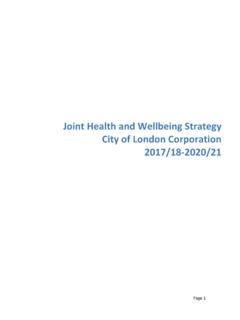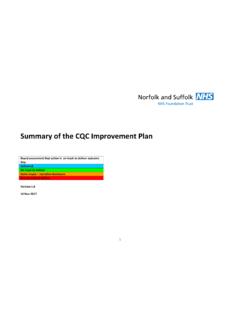Transcription of South East London: Sustainability and Transformation Plan
1 South east london : Sustainability and Transformation Plan21 October 2016 Key information detailsNameof footprint and no: South east london ; no. 30 Region: South east london (Bexley; Bromley; Greenwich; Lambeth; Lewisham; Southwark)Nominated lead of the footprint including organisation/function: Amanda Pritchard, Chief Executive, Guy s and St Thomas NHS FTOrganisations within footprints: CCGs: Bexley; Bromley; Greenwich; Lambeth; Lewisham; SouthwarkLAs: Bexley; Bromley; Greenwich; Lambeth; Lewisham; SouthwarkProviders: Guy s and St Thomas' NHS FT; King s College Hospital NHS FT; Lewisham and Greenwich NHS Trust; South london and Maudsley NHS FT; Oxleas NHS FT; Bromley Healthcare CIC; and primary care providersDartfordand Gravesham NHS Trust are an associate organisation, but formally sit outside of the footprint2 Draft in progress |SectionPageOur challenges and priorities1 plan on a page6 Developing consistent and high quality community based care (CBC) and prevention8 Improving quality and reducing variation18 Improving productivity and quality through provider collaboration30 Optimising specialised services across South east and South London35 Delivering our plan will require a change in how we work38 Bridging our financial gap41 Making progress in 2016/1743 ContentsIn South east london (SEL) we have a history of partnership working.
2 This includes collaborations between commissioners and providers, across health and social care, with the voluntary sector and citizens and with education and research institutions and networks. The six South east london CCGs have in place a well-established collaborative approach, and work with all of london 's 32 CCGs and NHS England to enable Transformation across the capital, including through the Healthy london Partnership (HLP). Providers work together as part of formal and informal clinical networks, including specialised services supported by our King s Health Partner s (KHP) Academic Health Science Centre. Organisations in the footprint also contribute to and use resources developed by support infrastructures such as the Health innovation Network (HIN) and Collaboration for Leadership in Applied Health Research and Care (CLARHC). The provider landscape is changing as we welcome the development of 15 at scale primary care federations covering all of South east CCGs were developing a Transformation strategy previously, the STP process has broadened this and has taken it much further by bringing organisations together to establish a place based leadership and decision making structure (that is, one which focuses on the population of SEL rather than the individual organisations).
3 The aim of this is to collectively identify our priorities and to help ensure that health and care services are built around the needs of plan outlines our collective understanding of the challenges we face and sets out our approach and actions to address date, we have established: A single responsible officer supported by a quartet leadership drawn from local government, commissioners, providers and clinical leadership, and a strategic planning board to provide direction and oversight Collaborative oversight and decision making bodies at various continue to work at: Leadership and governance development, including development of a MOU A single reporting structure bringing transparency across the system The establishment of a single version of the truth setting out our challenges, including our financial have committed to improving services for our residents within the resources available to us.
4 We recognise that the status quo is unsustainable and, in order to deliver the Transformation required, we need to change how we work together to overcome barriers to delivering our shared priorities. Over the next five years we will: Support people to be in control of their physical and mental health and have a greater say in their own care Help people to live independently and know what to do when things go wrong Help communities to support each other Make sure primary care services are sustainable and consistently excellent and have an increased focus on prevention Reduce variation in outcomes and address inequalities by raising the standards in our health services Develop joined up care so that people receive the support they need when they need it Deliver services that meet the same high quality standards whenever and wherever care is provided Spend our money wisely, to deliver better outcomes and avoid wasteOur commitmentsIntroduction3 Draft in progress |Our challenges and prioritiesLocally, we face many of the challenges that are experienced nationally.
5 The three gaps that are identified in the Five Year Forward View are found in South east london , and our plan will seek to address these. We are clear about the challenges people face in living healthily and wellThe health of our population has improved significantly over the last five years, but there is more to be done. A detailed case for change has been developed to understand the health and wellbeing needs of our population. In summary: We have a vibrant, diverse and mobile population with extremes of deprivation and wealth. 26% of children are classified as living in poverty, concentrated in certain parts of SEL; Premature death and differences in life expectancy are significant issues; 75% of over 55s have at least one LTC, while 32% of children are overweight or obese; We need to improve the health of the population overall. Keeping well, at all ages, is critically have developed a model (below) that segments our population into groups depending on their condition and level of risk, in terms of both physical and mental health.
6 The 50% of our population who are affected by inequalities or are putting their health at risk is too high; ensuring more of our population are enabled to stay well is imperativeto prevent our challenges getting : the financial graphic represents spend per patientWhile we have made progress we can do more as a system to improve our care and quality gapThe quality of care that patients receive too often depends on when and where they access services. We don t consistently meet quality and performance standards, and some providers are not rated good or outstanding by regulators. We don t always deliver services that address people's mental and physical health needs in an integrated way. Our services often do not detect problems soon enough, which can result in admittance to hospital in crisis where earlier support could have produced a different outcome. Our system is skewed towards hospital careWe don t invest enough in services based in the community which prevent illness or encourage people to manage their own physical and mental health.
7 As a result, people go to hospital when they could be better supported in the community, and can stay in too long once admitted. There is an opportunity here to provide better value care through our investment in the health and care system is fragmented resulting in poor patient experience, duplication and confusionOur system is made up of multiple organisations and professions which too often work within the confines of their own boundaries. This is reinforced through fragmented commissioning structures meaning that it is difficult to share resources. This impacts care and experience. Patients and carers find it frustrating to have to navigate different services and to provide the same information to different people. Patients often stay in hospital longer because joined up arrangements for their care in the community on and after discharge have not been put in services are under increasing pressureAll services in our system are facing increasing pressure to deliver high quality care within a constrained financial climate.
8 We are delivering in partnership with councils who face unprecedented pressures on resources. In some cases they are looking to save over 30% of current expenditure over the next 3-4 years. Recruitment and retention of our workforce has become increasingly challenging and our estates are not always fit for purpose. Our use of data and information management and technology (IM&T) doesn't currently enable our vision. Without a placed based approach to commissioning and contracting of care we will not optimise (1%)18,0003+ LTC (9%)153,000 Early stages of LTC (25%)445,000 residentsPeople experiencing inequalities or putting their health at risk(49%)870,000 Health and wellbeing group (16%)276,000 People with multiple complex needs where standard service are not effective who need personalised careCosts4 Draft in progress |7,882 8,735 6,000 6,500 7,000 7,500 8,000 8,500 9,0002015/162016/172017/182018/192019/20 2020/21 System-wide income/expenditure ( millions)Affordability challenge FY20/21 RevenueExpenditureWe are facing a financial challenge of 934m over four yearsdeliver system savings of 73m.
9 Taking into consideration growth assumptions over the next 5 years, we have calculated the increase in bed capacity that would be needed. If we do not change our approach to delivering care, the projected demand would increase so that the number of beds needed would be enough to fill a new hospital site, something which is not possible or affordable. It would also require a significant increase in our workforce. Our priorities must therefore focus on managing this increase in demand by changing the way we work so we can work within our current infrastructure. This will be by providing alternative high quality, good value options that focus on outcomes for our this, the footprint has a do nothing capital expenditure requirement of over the period to 2020/21. Of this, 983m is funded from identified sources. The approval process is underway for the remaining 153m addition to the NHS challenge outlined in the chart above, the financial challenge that the councils face over the period to 2020 is 242m.
10 Across the six boroughs, the overall spend on adult social care is just over 576m. By 2020 the boroughs will need to contain cost pressures of 132m2and are planning to make combined budget reductions in their adult social care budgets of 110m. This means that the six councils need to reshape social care services to lower costs and raise productivity. Each council is working to transform services at the local level with health sector partners. Lewisham, for instance, is conducting a devolution pilot to fast forward a number of initiatives so as to test some of the savings options early in the planning period. In the light of the complex patient and service user pathways across health and social care, there is considerable scope for achieving a substantial quantum of these savings through collaborative work across the OHSEL (oneofthebusinessrulessetbyNHSE ngland).










